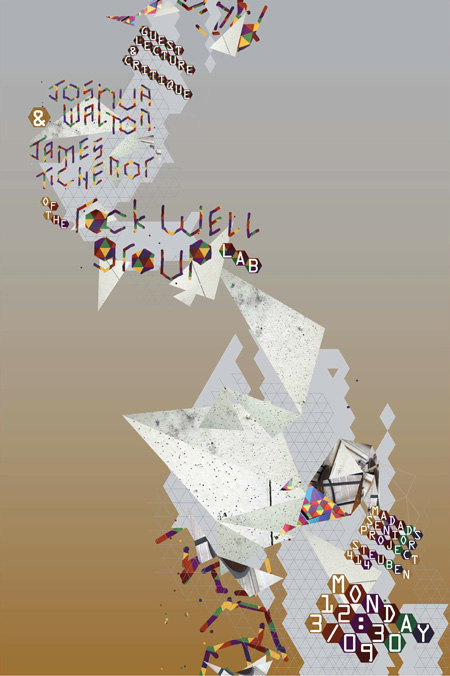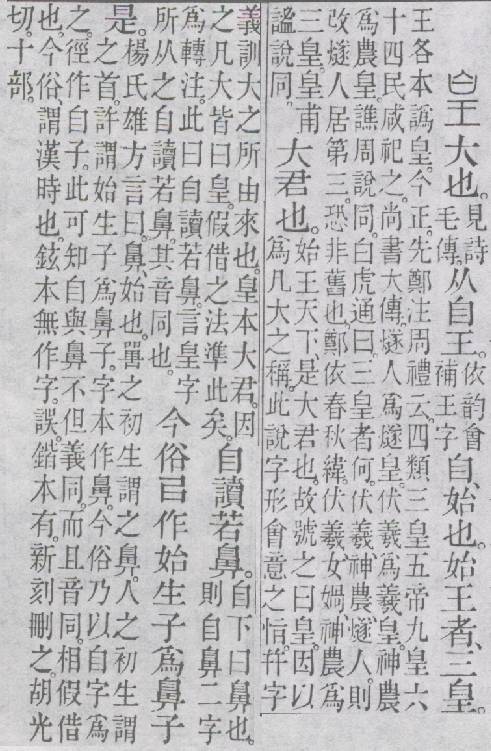
Guest Lecture & Critique
Joshua Walton + James Tichenor
Rockwell Group’s Interaction Lab
Ali Madad’s Senior Project
12:30pm 3/09/09
Steuben Hall 414

Guest Lecture & Critique
Joshua Walton + James Tichenor
Rockwell Group’s Interaction Lab
Ali Madad’s Senior Project
12:30pm 3/09/09
Steuben Hall 414
This past weekend Princeton University hosted BETTER: Design for Social Causes, a conference to discuss how graphic design can serve as a vehicle for social change. The event brought together practicing professionals and students, to confront designer’s ability to shape society’s conscience. How can design compel disaffected audiences to take action on social issues? How is it possible to sustain a career designing for social causes?
Speakers included:

Jessica Helfand & William, Partners at Winterhouse
“A Design Practice in Evolution: Rethinking Cultural Engagement and Social Innovation”

Debra Rizzi, Partner at Rizco Design
“One Change Now: Preserving the Environment One Design At a Time”

Jeffrey Zeldman, Executive Creative Director at Happy Cog Studios
“Design as Partnership”

Brian Collins, Founder of COLLINS: & Leland Maschmeyer, Director of Strategy, COLLINS:
“What’s the Story?”

Abbott Miller, Partner at Pentagram New York
“The New Materialism”

Posters on display, submitted for Sustainable Design Contest focusing on the topic of environmental sustainability. The entries were judged by the panel of speakers.

One idea that elite universities like Yale, sprawling public systems like Wisconsin and smaller private colleges like Lewis and Clark have shared for generations is that a traditional liberal arts education is, by definition, not intended to prepare students for a specific vocation. Rather, the critical thinking, civic and historical knowledge and ethical reasoning that the humanities develop have a different purpose: They are prerequisites for personal growth and participation in a free democracy, regardless of career choice.
This crisis of confidence has prompted a reassessment of what has long been considered the humanities’ central and sacred mission: to explore, as one scholar put it, “what it means to be a human being.”
http://www.nytimes.com/2009/02/25/books/25human.html?ref=opinion
To the Editor:
During my 40 years teaching European history at Trinity College, my answer to the question “What do you do with a history major?” was, “Nothing, unless you want to teach.”
The better question is, “What do history majors do?” And the answer is, “Everything — law, business, finance, medicine, journalism, politics and much more.”
To the Editor:
It is shockingly inappropriate to reduce support for the humanities when most of the problems we are faced with in the nation and the world are the result of deficiencies in integrity and ethics, not deficiencies in vocational skill sets.
To the Editor:
Your article reminded me of a sign taped to the door to the classics department in the early 1960s at Yale, where I majored in Latin: “Studying the classics teaches you the values you need to live without the money you give up because you studied the classics.”
To the Editor:
An important aspect of the humanities mentioned in your article needs to be spelled out. “Critical thinking,” many would agree, is valuable, and the humanities promote it. But what is it?
It is the ability to ask pertinent questions on any subject of human concern, recognize pertinent and defensible answers, and reject spurious or irrelevant ones. Equally, it is the habit of doing so, an intellectual virtue.
http://www.nytimes.com/2009/03/02/opinion/l02humanities.html?_r=1

 The Ivanics brothers: Ferenc and István—two Hungarian guys from Serbia—lived as a member of a minority in a war-worn post-communist country, and that is the best school to teach you how valuable peace is. And not only how valuable it is, but how hard it is to keep it: don’t bother about super powers, don’t bother about weapon bussiness, just focus on your own connections to people in your narrower or wider surroundings. The peace of small communities will lead to global peace. But how to communicate it? Many wise people are talking about peace, there are many ideas and theories about it, but words aren’t enough. The Ivanics brothers wanted to find a better, more powerful way to express their opinion. A really big thing, something interesting, something amazing, something that will be well recieved, that makes pepole think about peace and to change their lives. A walking tour around the world seemed to be appropriate…
The Ivanics brothers: Ferenc and István—two Hungarian guys from Serbia—lived as a member of a minority in a war-worn post-communist country, and that is the best school to teach you how valuable peace is. And not only how valuable it is, but how hard it is to keep it: don’t bother about super powers, don’t bother about weapon bussiness, just focus on your own connections to people in your narrower or wider surroundings. The peace of small communities will lead to global peace. But how to communicate it? Many wise people are talking about peace, there are many ideas and theories about it, but words aren’t enough. The Ivanics brothers wanted to find a better, more powerful way to express their opinion. A really big thing, something interesting, something amazing, something that will be well recieved, that makes pepole think about peace and to change their lives. A walking tour around the world seemed to be appropriate…
http://worldwalk-peacetour.info/
http://worldwalk-peacetour.blogspot.com/
This is the painting process of the Termesphere called A ROUND TOWN painted by Dick Termes for the Convention Center in Sioux Falls SD. It takes several months to complete an entire sphere.
A project started while studying at Rutgers University Camden, The Japan We Will Never See was an effort to surface the unseen and unheard. A series of negatives from pre, during, and post WWII Japan were stumbled upon at an estate sale, of which the only information to describe them were shorthand markings on envelopes. What became more interesting was the knowledge that short of their photographer, they had never been seen by anyone else. The question was then raised that, if a photographer captures an image, but does not share it, does it truly exist? And with that, could another person reinterpret their original intent?
Given the relative gravity surrounding this period of time in Japan, the answer is yes. What follows is a selection of the resulting prints. Individual names have been added with intent to humanize the images, making those depicted more than a historical statistic.
10×10″ Selenium toned prints on fiber paper

if anyone is interested….
http://www.internationalscientific.org/
《说文解字注》http://www.gg-art.com/imgbook/index.php?bookid=53
http://yuyuejiang.bokee.com/2340857.html

Hinamatsuri traces its origins to an ancient Japanese custom called hina-nagashi (雛流し, lit. “doll floating”), in which straw hina dolls are set afloat on a boat and sent down a river to the sea, supposedly taking troubles or bad spirits with them.
An Emperor doll, with two handmaidens.
The top tier holds two dolls, known as Imperial dolls (内裏雛 (だいりびな) da-i-ri-bi-na?) representing the Emperor (御内裏様 O-dairi-sama?) and Empress (御雛様 O-hina-sama?) (dairi means “Imperial Palace“, and hina means “girl” or “princess”).
The dolls are usually placed in front of a gold folding screen byōbu (屏風 ?).
Optional are the two lampstands are called bonbori (雪洞 ?), and the paper or silk lanterns are known as hibukuro (火袋 ?), usually decorated with cherry or plum blossom patterns.
Complete sets would include accessories placed between the two figures, known as sanbou kazari (三方飾り ?), composing of two vases kuchibana (口花 ?).
The traditional arrangement had the male on the right, while modern arrangements had him on the left (from the viewer’s perspective).
The second tier holds three court ladies san-nin kanjo (三人官女 ?). Each holds a sake equipment. From the viewer’s perspective, the standing lady on the right is the long-handled sake-bearer Nagae no choushi (長柄の銚子 ?), the standing lady on the left is the backup sake-bearer Kuwae no choushi (加えの銚子 ?), and the only lady in the middle is the seated sake bearer Sanpou (三方 ?).
Accessories placed between the ladies are takatsuki (高坏 ?), stands with round table-tops for seasonal sweets, excluding hishimochi.
The third tier holds five male musicians go-nin bayashi (五人囃子 ?). Each holds a musical instrument except the singer, who holds a fan.
Left to right, from viewer’s perspective, they are the:
Two ministers (daijin) may be displayed on the fourth tier: the Minister of the Right (右大臣 Udaijin?) and the Minister of the Left (左大臣 Sadaijin?). The Minister of the Right is depicted as a young person, while the Minister of the Left is much older. Also, because the dolls are placed in positions relative to each other, the Minister of the Right will be on the viewer’s left and the Minister of the Left will be on the viewer’s right. Both are sometimes equipped with bows and arrows.
Between the two figures are covered bowl tables kakebanzen (掛盤膳 ?), also referred to as o-zen (お膳 ?), as well as diamond-shaped stands hishidai (菱台 ?) bearing diamond-shaped ricecakes hishimochi (菱餅 ?). Hishidai with feline-shaped legs are known as nekoashigata hishidai (猫足形菱台 ?).
Just below the ministers: on the rightmost, a mandarin orange tree Ukon no tachibana (右近の橘 ?), and on the leftmost, a cherry tree Sakon no sakura (左近の桜 ?).
The fifth tier, between the plants, holds three helpers or samurai as the protectors of the emperor and empress. From left to right (viewer’s perspective):
On the sixth and seventh tiers, a variety of miniature furniture, tools, carriages, etc. are displayed.
These are items used within the palatial residence.
These are items used when away from the palatial residence.